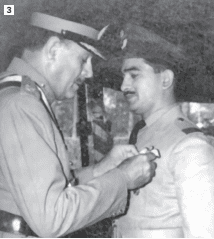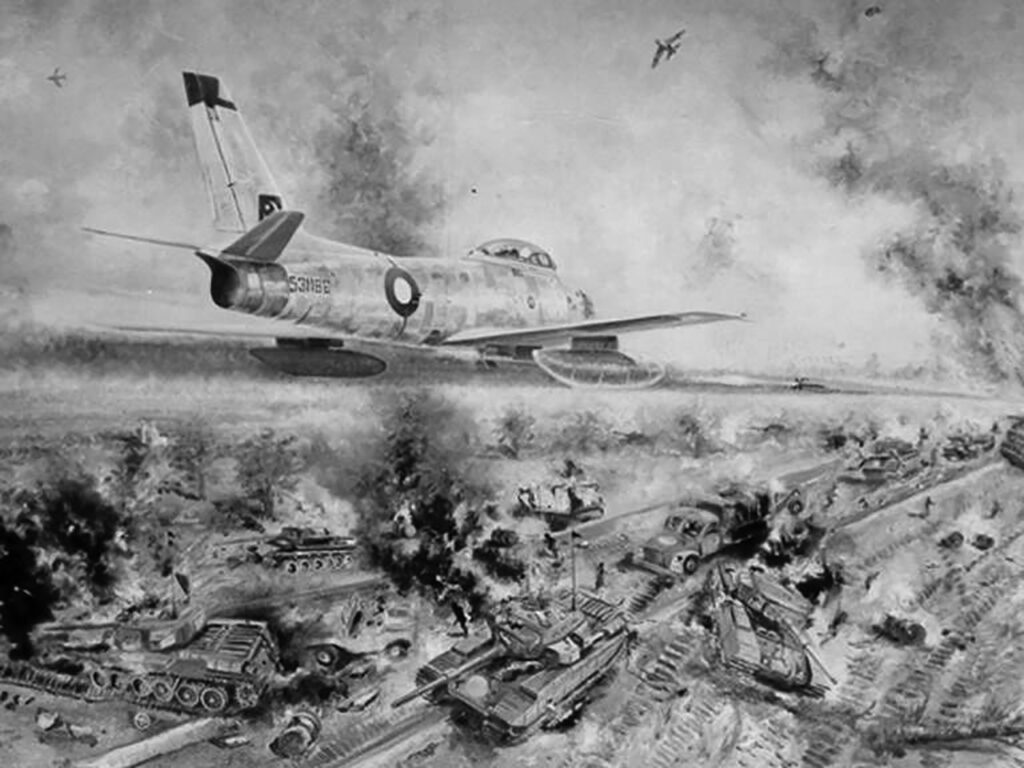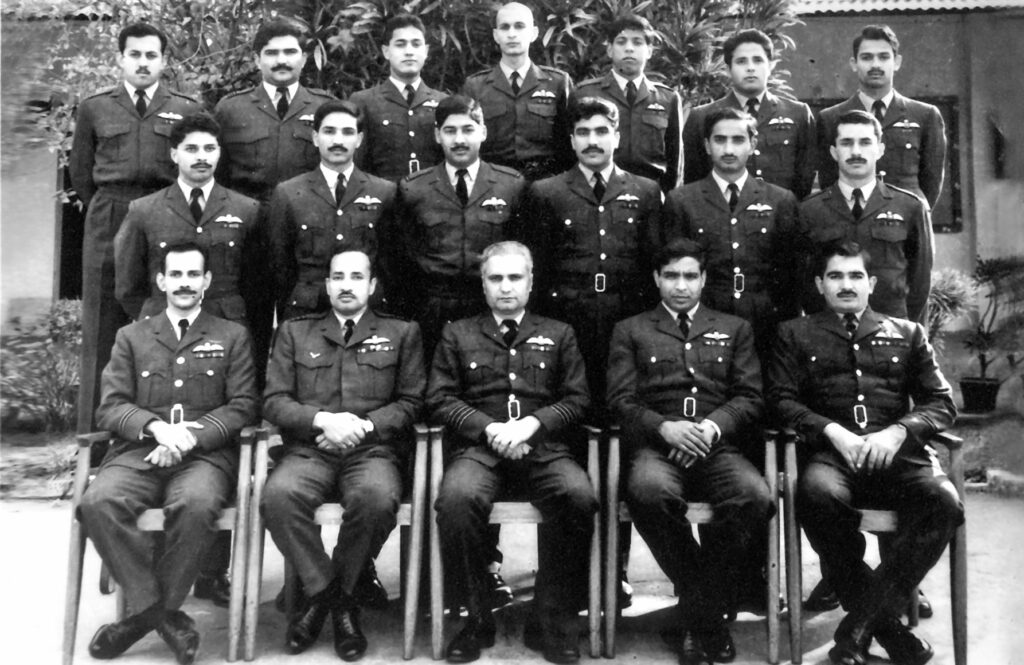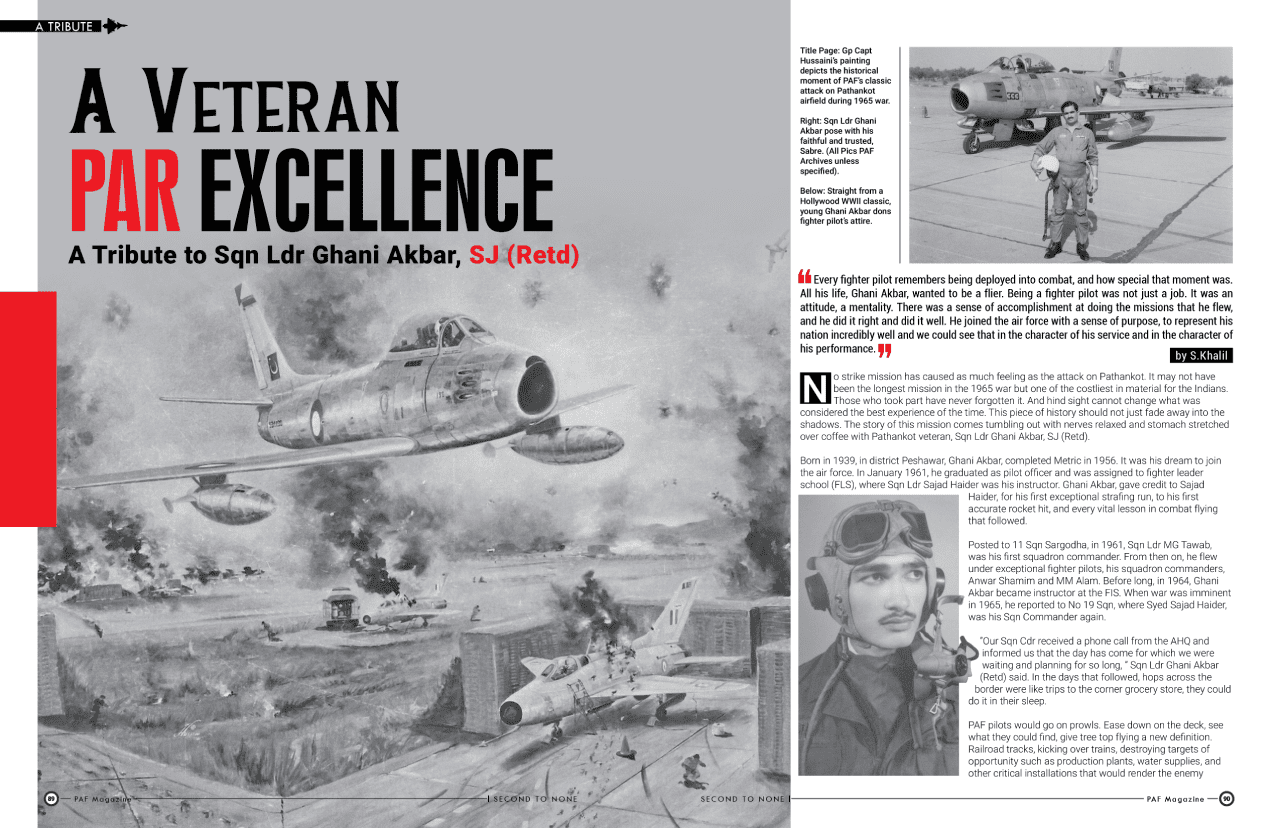A Tribute to Sqn Ldr Ghani Akbar, SJ (Retd)
Every fighter pilot remembers being deployed into combat, and how special that moment was. All his life, Ghani Akbar, wanted to be a flier. Being a fighter pilot was not just a job. It was an attitude, a mentality. There was a sense of accomplishment at doing the missions that he flew, and he did it right and did it well. He joined the air force with a sense of purpose, to represent his nation incredibly well and we could see that in the character of his service and in the character of his performance.
No strike mission has caused as much feeling as the attack on Pathankot. It may not have been the longest mission in the 1965 war but one of the costliest in material for the Indians. Those who took part have never forgotten it. And hind sight cannot change what was considered the best experience of the time. This piece of history should not just fade away into the shadows. The story of this mission comes tumbling out with nerves relaxed and stomach stretched over coffee with Pathankot veteran, Sqn Ldr Ghani Akbar, SJ (Retd).
Born in 1939, in district Peshawar, Ghani Akbar, completed Metric in 1956. It was his dream to join the air force. In January 1961, he graduated as pilot officer and was assigned to fighter leader school (FLS), where Sqn Ldr Sajad Haider was his instructor. Ghani Akbar, gave credit to Sajad Haider, for his first exceptional strafing run, to his first accurate rocket hit, and every vital lesson in combat flying that followed.

Posted to 11 Sqn Sargodha, in 1961, Sqn Ldr MG Tawab, was his first squadron commander. From then on, he flew under exceptional fighter pilots, his squadron commanders, Anwar Shamim and MM Alam. Before long, in 1964, Ghani Akbar became instructor at the FIS. When war was imminent in 1965, he reported to No 19 Sqn, where Syed Sajad Haider, was his Sqn Commander again.
“Our Sqn Cdr received a phone call from the AHQ and informed us that the day has come for which we were waiting and planning for so long, “ Sqn Ldr Ghani Akbar (Retd) said. In the days that followed, hops across the border were like trips to the corner grocery store, they could do it in their sleep.
PAF pilots would go on prowls. Ease down on the deck, see what they could find, give tree top flying a new definition. Railroad tracks, kicking over trains, destroying targets of opportunity such as production plants, water supplies, and other critical installations that would render the enemy unable to make arrangements for necessary war supplies and unable to sustain its forces enough to maintain support for the war – stop the enemy cold.
“On 6 September, we got a mission for Jassar, near Narowal, Punjab, where Indians were pounding our troops with artillery shells. Enroute to Jassar, the Leader got a call to abandon the mission and head towards Wagah border,” Ghani Akbar recalled. The six jets, led by Sqn Ldr Sajad Haider, No 2 Flg Off Arshad Ch, No 3 Flt Lt M Akbar, No 4 Tahir Kheli, No 5, …, and then a young Flt Lt Ghani Akbar flying at No 6, set course to Lahore, and descended over Shalimar. “We followed tracks, and destroyed tanks, guns, and artillery posts – the Indian attack was repulsed,” he said. The formation returned to Sargodha to refuel and then to home base Peshawar.
For something much bigger was in the making
As soon as the formation landed at Peshawar, attack orders were transmitted to destroy Pathankot. Sqn Ldr Sajad Haider would lead the show. There was a briefing, informal, short, to the point, enemy money handed over to all, instructions to get back alive. Sajad Haider laid down a synchronized plan of battle. He didn’t have to draw it for them. They had been doing this every day, twice thrice a day even.
The Sqn Ldr selected the team of eight attack aircraft and two more for combat air patrol (CAP). Sajad Haider led, and his No2 Flg Off Arshad Ch, No 3 M Akhbar, No 4 Tahir Kheli, No 5 Flg Off and No 6 Abbas Khattak, No 7 Mazhar, No 8 Flt Lt Ghani Akbar, and for the CAP mission, Wg Cdr Tawab and Flt Lt Arshad Sami, would fly No 9 and No 10. Ten F-86 jets lined up nose to tail for the take-off, surged into the air and formed quickly, climbing to altitude they would need before they went over India. Emphasis on timing to the split second. The leader made the decisions, made the decisions, the rest followed at his wing, he turned, they turned, he climbed, they climbed, up into a world that belonged to them. Getting close. Pathankot airfield, right on the nose, spread out like a diagram, flying in two formations of 4s, the F-86 dropped down on the airfield for rocket attack run, concentrating on definite objectives, blasting away the runway, bunkers, bombers and fighters, it was the same enemy. Flames everywhere.
“Everything was ablaze, when I caught sight of one more target on the ground, a Mystere, when pulling up. I decided to make a second pass for attack,” Ghani Akbar said.

“Exit,” shouted the leader Sajad Haider and so did Wg Cdr Tawab. But it was war, and one could not always stick to standard operating procedures (SOPs). Ghani Akbar peeled off as the rest of the formation continued. Every nerve and muscle now focused on the new target. Hell on earth ensued as Ghani Akbar opened fire again and there were flames. Got it burning nicely and made an exit.
It was a special daylight delivery service that PAF ran. Skeletal frames left with nothing else, room sized craters, besides the lingering effects that have lasted till date, ringing the ears, post traumatic stress disorders. Indian’s caught in the crosshairs could do nothing but run or duck in cover. Words cannot describe the energy released by the bombs, knocking the wind out of India, followed by the most putrid tasting ammonia dust that swept through the Pathankot airfield. The campaign’s defining moment is cited as the single most destructive act of war of the 1965 and 1971 air campaigns put together.
All the aircraft had climbed back to rally point, fuel gauges now close to empty, and as planned, the formation headed home to Peshawar except Ghani Akbar..
The jets had enough fuel for a single pass, not two. Ghani Akbar was now praying to God. Realizing he would not have enough gas to return to Peshawar, Ghani Akbar decided to go to Sargodha instead. “It had gotten dark, the runway was not visible and fuel was depleting fast,” Ghani Akbar said. Never before had he prayed to God like he did that day, “Allah help me, I will gain nothing if I crash.” And just then he saw the airstrip at Sargodha and landed. “In the middle of the runway I flamed out,” he quipped.
Time for another crack at the Huns
Pathankot, or what was left of Pathankot, was the fulfillment of a promise. But this was not one and done raid. Roused by the success, the brass that ran the war, had decided to weaken the entire Indian might. The PAF were quick to exploit the new tactics the very next evening. Pathankot airfield was the critical target of the Indian war machine. If the PAF could dismantle it, India’s capabilities would be strongly hindered, said Ghani Akbar.
Flt Lt Muhammad Akbar, No 2 Flt Lt Ghani Akbar, No 3 Sqn Ldr Sajad Haider, flew 500 ft, in their F-86s, equipped with fuel tanks, rockets, guns, bombs, and cameras. In the distance, the pilots could see a glow of fire. “It was like a red carpet,” Ghani Akbar said. The formation was forced to turn back by heavy Indian ack ack fire.
After the war ended the air force kept Ghani Akbar flying. Sunday was like Monday and Monday was like every other day, a working day, the sound of airplane engines waking up crews at dawn, getting ready for training missions.
In 1971, another chapter in the poisonous relationship between Pakistan and India opened. The two countries had gone to the brink again. The tactical importance of this bombing run was as significant as the psychological impact proved immense. PAF air power fulfilled its deadly potential during the bombing offensive over Bathinda. Yet this epic of PAF heroism has been relegated to folklore. There are no commemorations of the carnage that six PAF pilots caused.
The year is 1971. Pakistan and India are at war for the third time. Radars track every aircraft aloft. It does not take long for six yellow blips to stick out from the herd. Filling the headphones of Flt Lt Ejaz, patrolling the Eastern border, are coordinates of the intruders and new mission directives to intercept them. His wartime mistake could have marred an iconic campaign of the Pakistan-India 1971 war.
This story leaps out of black and white on a frosty Sargodha morning. It is a rare insight and first hand account of a red hot mission. PAF high command had concluded that aerial bombing of Bathinda railway junction would hinder Indian offence at Sahiwal. It came with significant risks, with the possibility of being captured or destroyed. Huge responsibility fell on six “lucky” young pilots.

Pathankot war veteran, Sqn Ldr Ghani Akbar, is assigned this special duty. He is to pick top six pilots and indiscriminately bomb Bathinda railway junction, in broad daylight. “Flying into Indian airspace was taking a huge risk. It was a suicide mission,” recalled Sdn Ldr Ghani Akbar.
For this job he selected Flying Officer Abraham, as his No 2, Flt Lt Bhatti, his No 3, and Flt Lt Khudadad Khan “KD”, as his No 4. Sdn Ldr Aftab Raja, No 5, and Flg Off Aurakzai, No 6, will fly combat air patrol (CAP) above and provide air cover while Ghani Akbar and his wingmen gave the enemy a sharp taste of aerial warfare.
This group had jumped across the border several times each day for strike missions in their venerable F-86s in the 1965 war with India, picking off tanks, convoys and military logistics. Despite the excitement, they were nervous. “This mission was different. Our appetites were spoiled. As their leader I tried to show confidence in the mission and tried eating. It felt like chewing on wood. We were all so tense,” Ghani Akbar said. They had no clue how the Indians would jump them when they crossed the border. Ack-Ack and SAMs were all ready and keeping an eye for intruders in the sky.
Base commander, whispers time on target (TOT) – 4:05 pm. The group goes into a deep huddle for last minute specific planning. Jeeps carry pilots to the planes. The six pilots ride out to six F-86s. No one knows what lies ahead. Time for start-engine nears. Minutes later all six are airborne. Sqn Ldr Ghani Akbar flies ahead, and the other five get into position before he makes a half turn. Now the whole group sets course in battle formation and zooms towards the Indian air space.
Bathinda railway junction is a flat place, of warehouses, depots and factories and all those other ingredients that nestle on the backs of postcards. In 1971 it bristled with armament and supplies. This formidable stronghold of ordinance put Bathinda high on the list of PAF bombs. But it was savagely defended by the Barnala radar to the east, and two air bases to its north and south.
“It was very precise targeting, on precise location to destroy and stop logistic support to India’s war machines against Sahiwal. We were told that the army would roll in and do the rest. That was the mission,” Ghani Akbar said.
The six ship formation fly deck level. That’s less than a hundred feet above ground – closing in like a shark sensing blood in the water. “We were so low, we could see enemy trenches where Indian soldiers were cooking their meals.
Throttles are pretty much kept forward. No 5 and No 6 climb to high positions above the formation of the bombers. The four-ship commenced their slashing attack. Munitions are dropped and smoke from the first explosion covers the terminal. “It was hammer, hammer, hammer all the way,” Ghani Akbar said. There goes what used to be the biggest railway crossing in Asia.
The four planes scored some direct hits on strong points along the junction – warehouses, railway intersections destroyed and the enemy’s fighting spirit weakened, all in less than three and a half minutes. Their training had served them well. Pilots maneuver their jets at body crushing G force speeds to fly clear of danger. Weaving above the bombers as top cover, dismayed No 5 and No 6, see no Indian jets coming for them. The two winged friends join the four-ship and head home. Throttles blasted forward.
Welcome is the sight of the Pakistan India border. But the battle has not ended. The speed of combat was so fast that radars at home mistook the returning jets for intruding Indian planes looking for revenge. As pilots switch to the radar channel, Flt Lt Ejaz has the “intruders” in sight and decided to intercept them. But he hesitates before following through the mission and decides to rely on his battlefield judgment. He establishes radio contact to confirm if the target is hostile. “Red Leader, waggle wings,” he orders. The opportunity to abort presents itself. Had Ghani Akbar failed to oblige, he would have been shot out of the sky by his own course mate. Flt Lt Ejaz, cusses at the ground controls with chilling news that the so called intruders are actually friendlies. The pilots land in an evening they will never forget. Ghani Akbar was proud of the job they had done and thankful that all six returned home safe. It was a day for records.
“It would’ve given us more thrill if we could see it,” said Ghani Akbar. They did not know how good they were until India bemoaned over the radio of the destruction PAF pilots left behind. Fast forward many years. While waiting for a connecting flight at the Amsterdam airport, he made acquaintances with a family from Bathinda. They didn’t have memories from that day, they had scars. The Sikh woman sketched a grim image of the bombing raid that made you think of a graveyard of supplies and ordinance. “It was a horrible day, the PAF pilots kept attacking the area for minutes and we could hear loud bangs,” the eyewitness told Ghani Akbar as she reminisced.
“I was glad that years after this attack some eyewitness confirmed what we achieved that day. It was a sigh of relief,” Ghani Akbar quipped.








